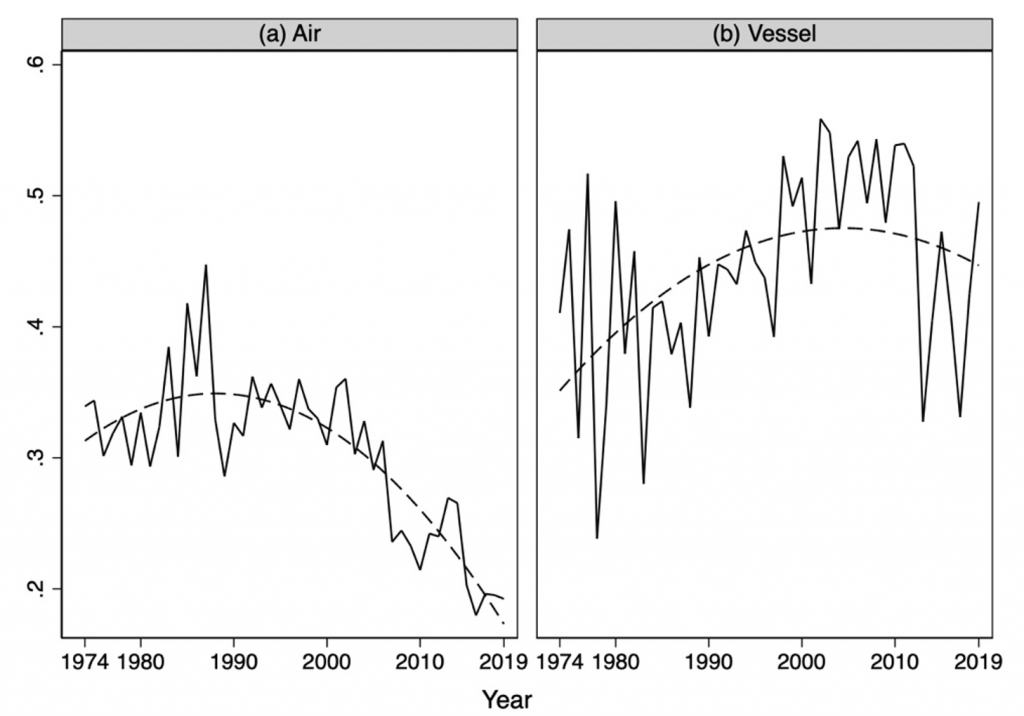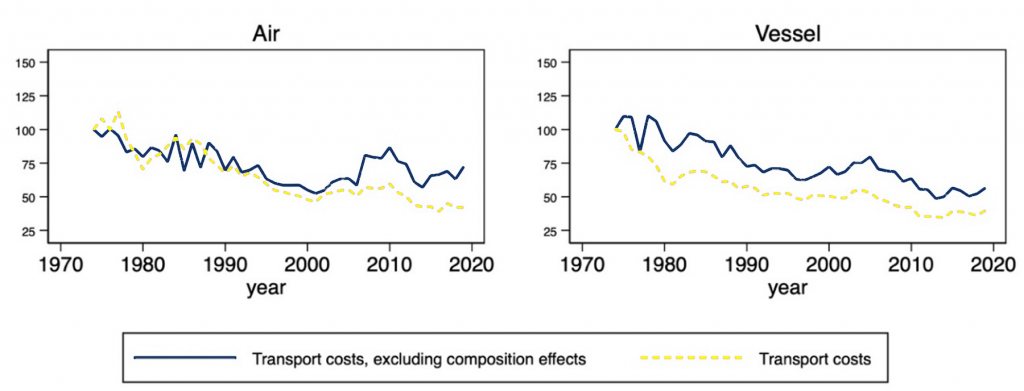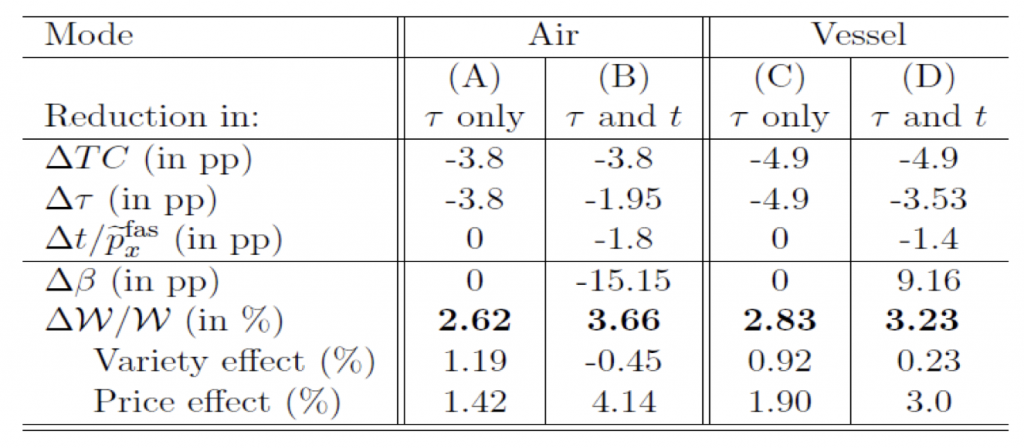_ Guillaume Daudin, professor, University of Paris Dauphine-PSL; Jérôme Héricourt, professor, Université Paris-Saclay, Univ Evry; Lise Patureau, professor of Economics, University Paris-Dauphine. VoxEU, 23 July 2022.
Although transport costs have decreased substantially over the past two centuries, they are still far from negligible. This column argues that in addition to standard ad-valorem transport costs, there is an important role for additive costs in trade models. We estimate that over the period 1974 to 2019, additive costs represented between 35 percent (in air transport) and 45 percent (in vessel) of total transport costs. Furthermore, accounting for additive transport costs helps characterise the downward trend in total transport costs since the 1970s and suggests that the gains from trade over the period have been larger than generally assumed.
…
Transport costs have decreased substantially thanks to technological advances in transportation, infrastructure development, and new communication technologies. From 1850 to 2020, maritime transport costs fell by 79 percent (Jacks and Stuermer 2021). Yet, international transport costs are far from being negligeable. Almost 20 years ago, Anderson and Van Wincoop (2004) pointed out that transport costs still represented around 30 percent of international trade costs (the rest being made of transaction costs, policy costs, and time costs). Disdier and Head (2008) also highlight that distance (a natural proxy for transport costs) is still a very important determinant of trade flows. More recently, the Covid-19 pandemic had a huge impact: transpacific freight rates at the end of 2021 are eight to nine times higher than the pre-pandemic norm (Waters 2021). Transport costs are with us and worth studying.
Having a clear view of the international transport cost burden is of key importance to several important economic issues, such as the gains from trade cost reduction. The usual way of modelling transport costs is to assume that they are ad-valorem, i.e. in proportion to the value of goods traded. Because they are multiplicative, such costs do not distort relative prices. Yet, this hypothesis contradicts day-to-day evidence of shipping price schedules that depend on volume and weight. Considering the existence of additive costs that are not in proportion to the value of goods traded and hence do distort relative prices challenges several received wisdoms in international trade. In this column, we argue that additive costs are quantitatively sizable and points out their effect in two dimensions: the role of composition effects in the decline of transport costs, and in international trade welfare computations.
Additive costs are important
While most of the international trade literature has modelled trade costs as an ad-valorem tax equivalent – i.e. as a constant percentage of the producer price per unit traded, part of Samuelson’s (1954) ‘iceberg cost’ hypothesis – recent papers point to the existence of an additive component, dependent on the physical quantities traded (Irrazabal et al. 2015, Martin 2012; but see the contrarian view of Lashkaripour 2020). How large is the additive component of international transport costs? Based on US imports data, we provide estimates of the size of both additive and ad-valorem transports costs by sector (at the three- and four-digit level, as well as HS10), country of origin, and transport mode (air and maritime transport) on a yearly basis over 1974-2019 (Daudin et al. 2022).
Additive transport costs are sizable. Over 1974-2019, we estimate them to be 1.7 and 2.8 percent of the ‘free alongside ship’ (fas) export price in air and vessel transport, respectively. These estimates are slightly lower than the ad-valorem component, which is 2.4 percent in air transport, and 3 percent in vessel. On average, additive costs represent between 30 percent (in air transport) and 45 percent (in vessel) of total transport costs.
Figure 1 displays the estimated share of additive costs in transport costs over the period. The additive component appears of sizable importance throughout the period in both transport modes. It also varies substantially over time, with a different pattern across transport modes. After a period of common increase in air and vessel from the mid-1970s to the end of the 1980s, the share of the additive component has steadily decreased in air transport. In contrast, it has continued to increase until the 2000s for vessel. Put differently, the total transport costs decrease comes mostly from the reduction of additive costs in air transport, while it is mainly driven by ad-valorem cost reduction in vessel transport. These results hold through a variety of empirical settings, including instrumental variables and the use of more disaggregated data.
Figure 1. Share of additive costs in total transport costs in US imports (1974 – 2019)

Note: The dashed line is the quadratic trend.
Going deeper into the decrease in international transport costs over time
Overall, we find that both air and vessel exhibit a downward trend in total transport costs (as a percentage of the export price) since 1974, by roughly the same magnitude of -2 percent on average per year (equivalently, a 60 percent decrease over the period). This decrease in overall transport costs might be due to a reduction of the ‘pure’ transport costs or to a change in the composition of trade (i.e. changes over time in the baskets of imported goods and the origin countries). We disentangle both explanations by decomposing the transport cost trends between the two ‘composition’ and ‘pure transport costs’ effects (see Figure 2). We find that the reduction in ‘pure’ transport costs (i.e. for a given sector/country partner) accounts for most of the downward trend in international transport costs over time, by 50 to 60 percent. Trade composition effects only play a limited influence and when they do, they tend to amplify the reduction in pure transport costs. This conclusion stands in contrast with Hummels (2007). Further investigating this difference, we show that the modelling of the additive component as varying over time, country partner, and product is key in the proper characterisation of the trend pattern of international transport costs (Daudin et al. 2022).
Figure 2. Composition effects in the reduction of transport costs (1974 – 2019)

Note: Transport costs are expressed in percentage of the value shipped, then built as indices with the reference value 100 in 1974.
Welfare implications
As additive transport costs distort relative prices, they should entail a bigger burden on welfare than ad-valorem costs. To investigate that issue over 1974-2019, we introduce additive costs in the canonical Melitz (2003) model.
Table 1 summarises our main results. The reported reductions in transport costs are based on our empirical estimates between 1974 and 2019. In running this exercise, we also consider the fact that the share of exporting firms has substantially increased in the US over the period of interest (nowadays equal to 39 percent according to Lincoln and McCallum 2018). This can be accounted for in the model by an appropriate decrease in the fixed cost of exports. For both transport modes (air and vessel), we contrast two cases: when the transport cost reduction occurs solely through a decrease in ad-valorem costs, as usually modelled in New Trade theories (figures in columns A and C), versus when it is achieved through a combined reduction in the ad-valorem and the additive components, as quantified by our empirical exercise (figures in columns B and D).
Table 1. Trade cost reduction: The role of additive costs

Note: Table extracted from Daudin et al. (2022). TC = Transport Costs, expressed in percentage of the average export fas price. τ and t stand for the ad-valorem and the additive cost respectively. The reduction in transport costs is expressed in percentage points. β is the share of additive costs in total transport costs. ∆W⁄Wmeasures the welfare gain (or loss).
For both transport modes, the welfare gains associated with a reduction in transport costs are much higher when this reduction is partly achieved through a reduction in additive costs. Accounting for additive costs increases the welfare gains of decreased transport costs by 14 percent in vessel and 40 percent air transport. Neglecting additive costs leads to a substantial underestimation of the welfare gains of globalisation.
What are the underlying mechanisms? In the canonical case with only ad-valorem costs, the welfare gains of a transport cost reduction can be viewed as the result of two opposite effects. As lower trade costs strengthen competition from foreign firms, entry becomes tougher on the domestic market. This reduces the number of varieties accessible to the consumers, hence welfare. Yet, as the firms serving the domestic market (either local or foreign) are also more productive due to the tougher selection, consumers benefit from lower prices. This price effect dominates, and the transport costs reduction generates welfare gains.
What changes when the reduction in international transport costs also occurs through a reduction in its additive component? The key factor is that the reduction in additive costs changes relative prices. The decrease in the additive cost indeed implies that the export-market price of the high-productive exporters declines relative to the low-productive ones (Sorensen 2014). In other words, the reduction in additive costs induces a within-exporters selection effect, in favour of the more productive firms. This amplifies the classic Melitz (2003) selection effect at the extensive margin. Both the (positive) price effect and the (negative) variety effects are stronger, but the former dominates, inducing even larger welfare gains than in the pure ad-valorem case.
Additive costs matter in international transport costs. Acknowledging this has important consequences for the study of the recent ‘hyper-globalisation’ period. On the descriptive side, this allows a better characterisation of the trend pattern of international transport costs. Namely, the decrease in ‘pure’ transport costs accounts for most of the overall reduction observed over 1974-2019. On the normative side, the welfare gains from decreased transport costs are markedly larger when their additive dimension is considered. This calls for further exploration of the role of additive costs, for example in shaping international trade flows and in the international transmission of business cycles.
References
Anderson, J and E Van Wincoop (2004), “Trade costs”, Journal of Economic Literature 42(3): 691-751.
Bernard, A B, J J Eaton, B Jensen and S Kortum (2003), “Plants and productivity in international trade”, American Economic Review 93: 1268-1290.
Daudin, G, J Héricourt and L Patureau (2022), “International Transport Costs: New Findings from Modeling Additive Costs”, Journal of Economic Geography, forthcoming.
Disdier, A-C and K Head (2008), “The puzzling persistence of the distance effect on bilateral trade”, The Review of Economics and Statistics 90(1): 37-48.
Hummels, D (2007), “Transportation costs and international trade in the second era of globalization”, Journal of Economic Perspectives 21: 131–154.
Irarrazabal, A, A Moxnes and L D Opromolla (2015), “The tip of the iceberg: A quantitative framework for estimating trade costs”, The Review of Economics and Statistics 97(4): 777-792.
Jacks, D S and M Stuermer (2021), “Bulking up: Booms and busts in maritime transport costs and their drivers”, VoxEU.org, 18 April.
Lashkaripour, A (2020), “Weight-based quality specialization”, Journal of International Economics 127: 103380.
Lincoln, W F and A H McCallum (2018), “The rise of exporting by US firms”, European Economic Review 102: 280-297.
Martin, J (2012), “Markups, quality, and transport costs”, European Economic Review 56: 777-791.
Melitz, M (2003), “The impact of trade on intra-industry reallocations and aggregate industry productivity”, Econometrica 71: 1695-1725.
Samuelson, P (1954), “The transfer problem and transport costs, ii: Analysis of effects of trade impediments”, Economic Journal 64: 264-289.
Sorensen, A (2014), “Additive versus multiplicative trade costs and the gains from trade”, Canadian Journal of Economics 47: 1032-1046.
Waters, W (2021), “Transatlantic air freight rates stay high despite added capacity”, Lloyd’s Loading List, Last accessed 30 June 2022.
* Republished from the original publication on VoxEU in accordance with their copyright rules.
